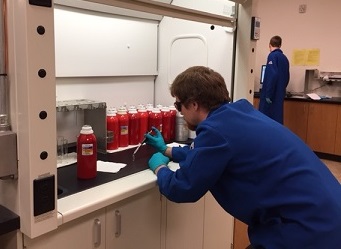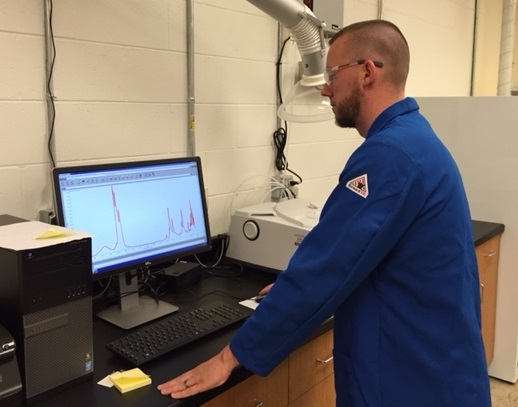ASTM International Standards
ASTM International is a globally recognized leader comprised of more than 30,000 of the world’s top technical experts and business professionals for the purpose of developing and delivering international voluntary consensus standards. ASTM standards are used around the world to improve product quality, enhance safety, facilitate market access and trade, and build consumer confidence.
Wisconsin adopts the following ASTM standards:
ASTM D396, standard specification for fuel oils.
ASTM D910, standard specification for aviation gasolines.
ASTM D975, standard specification for diesel fuel oils.
ASTM D1655, standard specification for aviation turbine fuels.
ASTM D3699, standard specification for kerosene.
ASTM D4806, standard specification for denatured fuel ethanol for blending with gasolines for use as automotive spark−ignition engine fuel.
ASTM D4814, standard specification for automotive spark-ignition engine fuel.
ASTM D5798, standard specification for ethanol fuel blends for flexible−fuel for automotive spark−ignition engines.
ASTM D6227, standard specification for unleaded aviation gasoline containing a non−hydrocarbon component.
ASTM D6751, standard specification for biodiesel fuel blend stock (B100) for middle distillate fuels.
ASTM D7467, standard specification for diesel fuel oil, biodiesel blend (B6 to B20).
ASTM D7547, standard specification for hydrocarbon unleaded aviation gasoline
Find more information about
ASTM.
Tests Performed by the Fuel Quality Laboratory
Vapor Pressure
Vapor pressure is important relating to the function and operation of gasoline-powered vehicles. High levels of vaporization are desirable for winter starting and operation and lower levels are desirable in avoiding vapor lock during summer heat. Thus, refineries manipulate the Reid Vapor Pressure seasonally specifically to maintain gasoline engine reliability.
The Environmental Protection Agency has placed maximum limits on gasoline’s vapor pressure during the ozone season (May 1 - September 15). In addition, those portions of Wisconsin that are required to use Reformulated Gasoline (RFG) must meet lower vapor pressure requirements because hydrocarbon emissions are precursors to the formation of ozone (smog).
Testing is performed in accordance with ASTM D5191 and D6378.
Distillation
The distillation (volatility) characteristics of hydrocarbons have an important effect on their safety and performance, especially in the case of fuels and solvents. The boiling range gives information on the composition, the properties, and the behavior of the fuel during storage and use. Volatility is the major determinant of the tendency of a hydrocarbon mixture to produce potentially explosive vapors.
The distillation characteristics are critically important for both automotive and aviation gasolines, affecting starting, warm-up, and tendency to vapor lock at high operating temperature or at high altitude, or both. The presence of high boiling point components in these and other fuels can significantly affect the degree of formation of solid combustion deposits. The temperatures at which 10 percent, 50 percent, and 90 percent evaporation occurs are often used to characterize the volatility of gasoline.
Testing is performed in accordance with the referee method ASTM D86. In addition, we have micro-distillation units that are used to screen fuel in accordance to ASTM D7345 and in perfect correlation with ASTM D86 (groups 0-4).
API Gravity
Producers of petroleum products developed this test so the specific gravity of liquids could be expressed in whole numbers. The API gravity is used along with the distillation temperatures for calculating the cetane index of diesel fuel. The specific gravity is defined as the ratio of the weight of a given volume of the product at 60º F.
Testing is performed in accordance with ASTM D1298.
Calculated Cetane
The cetane index is derived from a formula for estimating the cetane number of diesel fuel.
Testing is performed in accordance with ASTM D4737.
Flash Point
The flash point of a volatile material is the lowest temperature at which it can vaporize to form an ignitable mixture in air. Measuring a flash point requires an ignition source. At the flash point, the vapor may cease to burn when the ignition source is removed.
Flash point can also indicate the possible presence of highly volatile and flammable materials in a relatively nonvolatile or nonflammable material, such as the contamination of lubricating oils by small amounts of diesel fuel or gasoline.
Testing is performed in accordance with ASTM D56, D6450, and D7094.
Sulfur Content
Sulfur is an element that is normally found in varying amounts in all petroleum products. Sulfur in gasoline impairs the effectiveness of emission control systems and contributes to air pollution. Reducing the sulfur content in gasoline enables advanced emission controls and reduces air pollution.
Testing is performed in accordance with ASTM D5453.
Density
Density is a fundamental physical property that can be used in conjunction with other properties to characterize both the light and heavy fractions of petroleum and petroleum products. Determination of the density, relative density, and/or API Gravity of petroleum and its products is necessary for the conversion of measured volumes to volumes at the standard temperature of 15°C.
Testing is performed in accordance with ASTM D4052.
Cloud Point
For petroleum products and biodiesel fuels, cloud point of a petroleum product is an index of the lowest temperature of their utility for certain applications. This is determined by the temperature of a liquid specimen when the smallest observable cluster of hydrocarbon crystals first occurs upon cooling under prescribed conditions.
Testing is performed in accordance with ASTM D2500.
Water and Sediment
Used as an indication of water and sediment in middle distillate fuels such as Grade Nos. 1 and 2 fuel oil. The finished fuel shall be visually free of undissolved water, sediment, and suspended matter; it shall be clear and bright at the ambient temperature or 70°F, whichever is higher. Water and sediment in fuel is our program’s most frequent consumer complaint.
Testing is performed in accordance with ASTM D2709.
Octane
Octane number or Anti-knock Index (AKI) is determined through the use of a Fourier Transform Infrared (FTIR) spectrometer. This instrument is correlated to octane engine referee test methods, ASTM D2699 and D2700. The FTIR technology provides confidence that the consumer is receiving gasoline that meets minimum posted octane.

A sample’s absorbance is measured at various wavelengths, compared to reference standards and an Octane Number is calculated. Samples screened with the FTIR as ‘off specification’ are sent to a laboratory to perform testing with the referee methods. This is done for verification prior to enforcement action.
Ethanol Content
Ethers, alcohols, and other oxygenates can be added to gasoline to increase octane number and to reduce emissions. Type and concentration of various oxygenates are specified and regulated to ensure acceptable commercial gasoline quality. Drivability, vapor pressure, phase separation, exhaust, and evaporative emissions are some of the concerns associated with oxygenated fuels. Ethanol is routinely used for both quality control in the production of gasoline and for the determination of deliberate or extraneous oxygenate additions or contamination.
Testing is performed by use of a Gas Chromatograph (GC), in accordance with ASTM D4815.